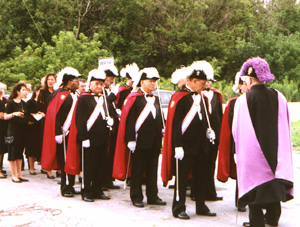 | In the entrance procession, the Knights of Columbus form an honor guard for the presider, Cardinal George.
|
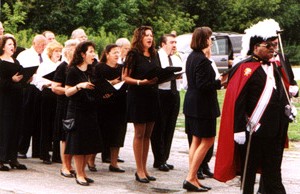 | In
procession, the choir is directed and led by Marty Bramlette. The choir
sings verses of Psalm 107 in Psalm Tone 8, from the hymnbook. The
people sing Alleuia, in response to each verse of the Psalm.
|
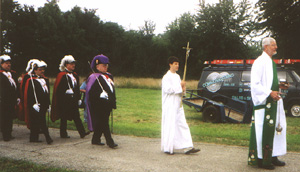 | Now
moving north, the procession is led in good order by Deacon Ray Deabel.
He is a full-time chaplain at St. James Hospital, Chicago Heights.
|
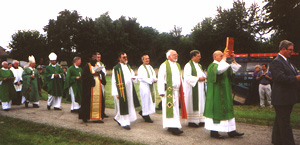 | From
the left are Deacon John Leonas, Father John McDonnell, Cardinal
George, Most Rev. Joseph Perry, Fathers Michael Gilligan, Ed Gleeson,
Jakob Thekeparampil, Sixtus Agostini (Comboni), Lou Cameli, Ron
Kondziolka, Wayne Prist, Deacon Bob Bonta (carrying the Gospel Book),
and John Pelley, in the choir.
|
On the left is Father Ed Gleeson, pastor of the historic St. James Church in Lemont. His parish also uses the Leaflet Missal,
as well as San Rocco. Father Jacob Thekeparmpil is a friend of
Father Gilligan, from the Societas Liturgica. Dr. Thekeparmpil is a
scholar of Syriac liturgy, from which is derived his own Syro-Malankar Rite
of the Catholic Church. Historically, with the Syrian Orthodox
Church, his Church has a high christology, much
like that of the Coptic Church. He is from Kerala, India, where he is director of the St. Ephrem Research Institute. Father
Michael Zaniolo has helped at San Rocco, especially for the San Lorenzo
Festival. He is now chaplain at O'Hare Airport.
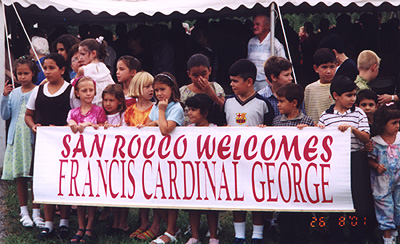 | As
the entrance procession concludes, the people sing "Ad Multos Annos"
("For many years may you live!") to Cardinal George. This is the first
of two songs in acclamation of his coming.
|
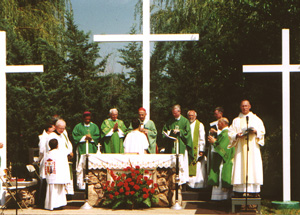 | After
the Opening Prayer by Cardinal George above, all sit down. Now that the
Introductory Rites are completed, there is a short break before the
Liturgy of the Word begins. Angela Palanca then sings "O Thou that
Tellest Good Tidings to Zion," from the Messiah. (This is also directed
to Cardinal George, because he is the one who decides that San Rocco
shall continue in existence.) The Liturgy of the Word then follows.
|
|
Pastoral Visit of Cardinal George to San Rocco Oratory Seeking
what he considered a final gesture of approval for the re-establishment
of the San Rocco community, August Anzelmo invited Cardinal George to
come to the oratory to celebrate Sunday Mass. The Cardinal
responded affirmatively to this invitation and came on Sunday, August
26, 2001, at Noon. The
clergy vested in the nearby Mt. Carmel Club, to the east, on
Wentworth. The opening procession moved west on 21st Street, to the
pathway leading to the grotto area. There, the
procession moved north, passing through the large tent set up
for the occasion. The sanctuary area, already set in stone, easily
accommodated the place where our bishop,
Cardinal George, would preside, with the clergy
around him, in the form of a crown. The choir stood on
risers, moved from the church building. The congregation, some
distance away from the clergy, was seated under the tent. It
was a warm day, and the sun's radiance was strong. There
were 300 chairs set out, all of which were taken.
Total participation was estimated at about 390, including
people from the neighborhood, especially nearby St. Paul's Church.
There were also some guests from Infant Jesus of Prague Church in
Flossmoor. Four
deacons assisted the bishop and the congregation: Bob Bonta,
Ray Deabel, Gene LaBelle, and John Leonas. Bob Bonta
was a deacon of the Gospel; he carried the Gospel Book in procession and
proclaimed the Gospel itself. Ray Deabel carried the incense and
led the entrance procession; he also attended the bishop, Cardinal
George. Gene LaBelle was a deacon of song; he led the congregation's
singing and sang the petitions of the General Intercessions. John Leonas
was a deacon of the Eucharist; he helped with Communion and attended
the bishop. In
this way, the bishop is surrounded by his presbyters ("priests") and
helped by his deacons. In the celebration itself, we see clearly
the threefold ministry of the ordained, the very structure of the
Church.
************************************
Stational Mass of the Bishop of the Diocese From the Ceremonial of Bishops, 119-122, 1179: The
preeminent manifestation of the local Church is present when the
bishop, as high priest of his flock, celebrates the Eucharist and
particuarly when he celebrates in the cathedral, surrounded by his
college of presbyters and by his ministers, and with the full, active
participation of all God's holy people. This
Mass, which is called the stational Mass, shows forth the unity of the
local Church as well as the diversity of ministries exercised around the
bishop and the Holy Eucharist. Hence, as many of the faithful as
possible should come together for a stational Mass. Priests should
concelebrate with the bishop; deacons should assist in the celebration;
and acolytes and readers should also carry out their ministries. The
form of the stational Mass should be retained . . . during pastoral
vistitations. The stational Mass should be a sung Mass, in accord with
the provisions of the General Instruction of the Roman Missal. It
is preferable that, as a rule, at least three deacons, properly so
called, assist in a stational Mass: one to proclaim the Gospel reading
and to minister at the altar, two to assist the bishop. If there are
more than three deacons present, they should divide the ministries
accordingly. At least one of these deacons should be charged with
assisting the active participation of the faithful [for example, the
singing of the congregation]. The
bishop . . . should be received in a manner suited to the circumstances
of the place and the situation. If this seems appropriate, the bishop
may be solemnly received and greeted by the clergy at the door of the
church. But the bishop may even be escorted to the church with festive
song, when this is feasible and appropriate. A dignified solemnity
in receiving the bishop is a sign of the love and devotion of the
faithful toward their good shepherd. [This is why we used two songs for this purpose: Ad Multos Annos and O Thou that Tellest Good Tidings to Zion. The solemn entrance procession, in good order, served the same end.]
**********************************
The Stational Mass (by Msgr. Alan Detscher) The
stational Mass, then, is no longer to be seen as a Mass with greater
ceremonial and solemnity on the occasion when the bishop celebrates the
Eucharist. Rather, the stational Mass should be a symbol of the local
Church at prayer, the Church presided over by the bishop of the diocese.
As the pastor ("shepherd") of the whole diocese gathers with members of
all the orders of the clergy, with those who exercise the various
liturgical ministries, and with the faithful of the diocese, to be
united with them as the praying Church. Hence,
each stational Mass must represent both the unity and diversity of the
ministries and people of the local diocesan Church, just as the
stational Masses of the ancient Roman Church reflected the unity and
diversity of that city. Whether celebrated in the cathedral, as
the mother church of the diocese, or in the smallest parish church, the
stational Mass must be a manifestation of the diocesan Church. It
is appropriate to emphasize at this point that the form that the
stational Mass takes must be adapted to concrete circumstances. What is
done in a small church cannot be the same as that which takes place in a
cathedral, and yet each must clearly reflect the theological reality of
the stational Mass. The
stational form of Mass is used for solemnities, for the Chrism Mass,
the Mass of the Lord's Supper, feasts of diocesan saints or patrons,
large gatherings, and pastoral visitations. On other occasions,
the bishop may well wish to celebrate in a simpler manner.
|



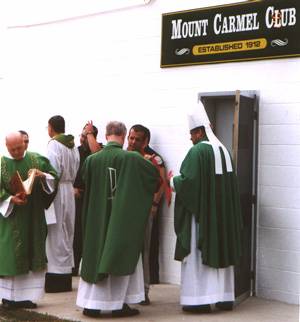




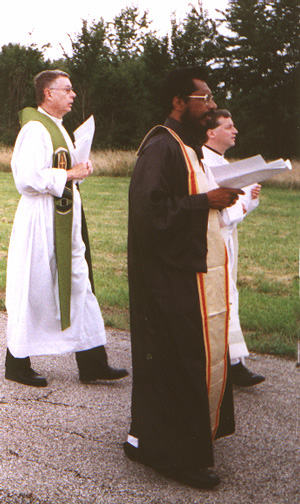
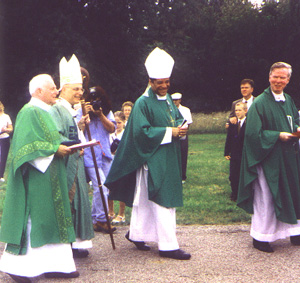


 top
top